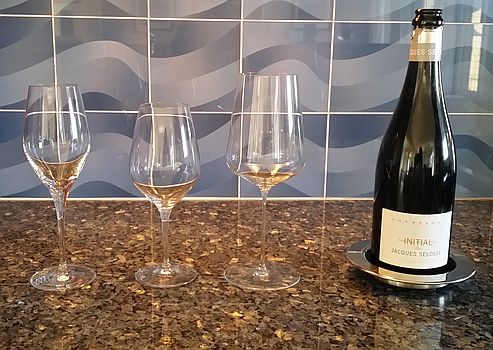Well, we went out yesterday and purchased a pair of Zalto Universal glasses. I could write a separate sidebar on how surprised I was to find them locally here in Wichita, KS, but suffice it to say I found them and with no markup. I have no doubt they’ll be good glasses for still whites and smaller reds, but this seemed to be a good opportunity to try them out for Champagne too. The angular appearance is different from our other glasses (Spiegelau Authentis and Riedel Somms), and Michelle said she didn’t particularly like the look, but we could give them a whirl anyway.
We did a side-by-side tasting with the Zalto Universal, Spiegelau Authentis white wine, and Spiegelau Authentis Champagne. The test wine was a Selosse Initial, disgorged 1/2013. This may or may not have been a poor choice, as it was our first Selosse. But I figured that since we had no preconceived notions of the wine, it would effectively generate a double-blind situation for the stemware too. That, and if we ended up not liking it very much, at least it got consumed in the name of science…

First up was the Spiegelau Authentis Champagne Flute. This glass is already more white-wine like than many flutes, as it has a defined bowl and tapers inward at the top. It presented a good vigorous mousse that was visually great, but (for me) made it hard to get a good assessment of the nose, as it generated rather a lot of prickliness. Palate was the most sharp of the bunch, and brought out the most of the BdB characteristics. Michelle liked this glass the best, and it clearly gave the most “festive” presentation.
Spiegelau Authentis White Wine was next. Here you lost some of the bubbles, but not too much. The prickly sensation was dissipated enough for me to get a good nose (mild citrus and yellow fruit, some nutty notes). A good balance between sharp acidity and fruit on the palate. Oxidation notes clearly present, but enough in the background that they weren’t bothersome to me. My favorite glass of the group.
The Zalto Universal was almost devoid of bubbles in glass, though they exploded on the palate. The visual appeal of the bubbles is a big part of the Champagne experience for both of us, so this was something of a letdown. Perhaps a bit more floral on the nose, and rather round and fat on the palate. Lots of emphasis on the oxidative nature of the wine, which was not appealing to me. Overall, this glass really made the wine seem like a still wine. It wasn’t bad, but changed the character of the wine more than I was expecting, and not for the better for our tastes.
I will say that in the end, neither of us particularly liked the Selosse Initial as a Champagne. I knew what we were likely to find in the bottle, but was surprised at how strongly oxidative the wine actually was. The color was significantly golden, to the point of what I’d call premox in a white burg of similar age. I suspect we’ll have to try this experiment again with a wine we know better, or at least one that fits a more traditional champagne profile. Still, the exercise was educational and showed to us that a different glass really does make a difference in what you taste.




